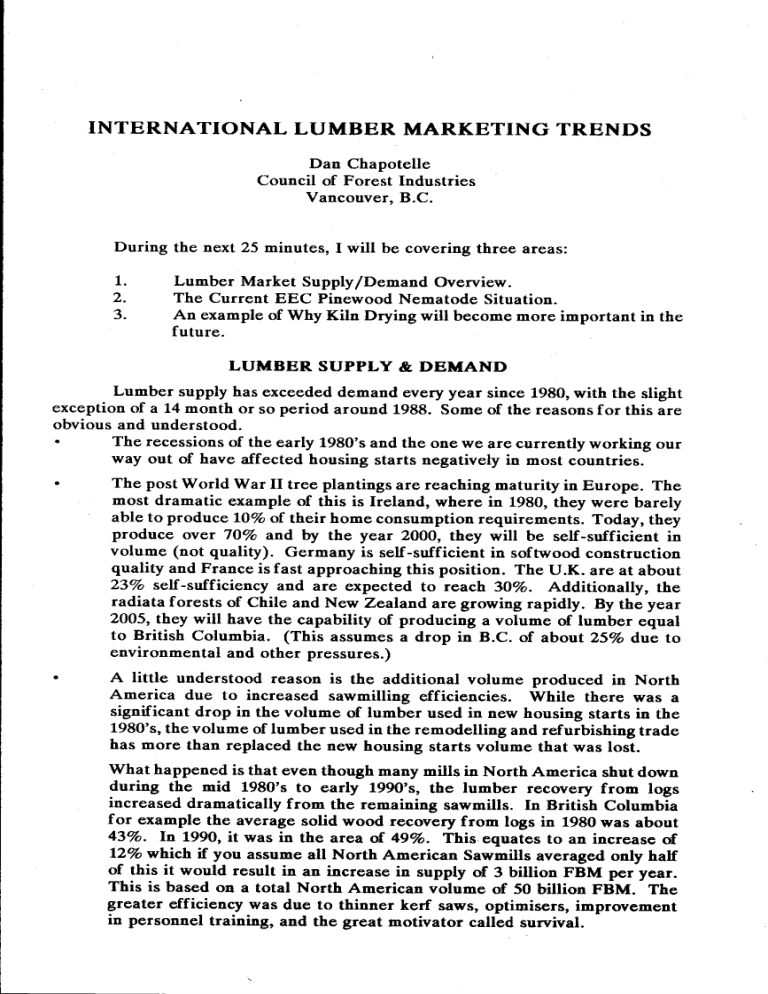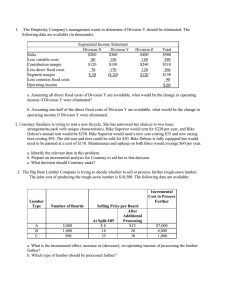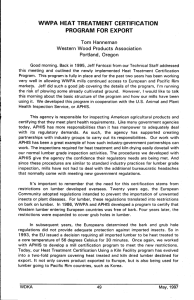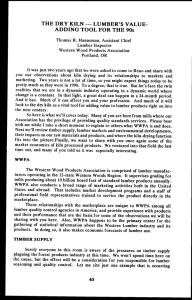INTERNATIONAL LUMBER MARKETING TRENDS

INTERNATIONAL LUMBER MARKETING TRENDS
Dan Chapotelle
Council of Forest Industries
Vancouver, B.C.
During the next 25 minutes, I will be covering three areas:
1.
2.
3.
Lumber Market Supply/Demand Overview.
The Current EEC Pinewood Nematode Situation.
An example of Why Kiln Drying will become more important in the future.
LUMBER SUPPLY & DEMAND
Lumber supply has exceeded demand every year since 1980, with the slight exception of a 14 month or so period around 1988. Some of the reasons for this are obvious and understood.
• The recessions of the early 1980's and the one we are currently working our way out of have affected housing starts negatively in most countries.
• The post World War II tree plantings are reaching maturity in Europe. The most dramatic example of this is Ireland, where in 1980, they were barely able to produce 10% of their home consumption requirements. Today, they produce over 70% and by the year 2000, they will be self-sufficient in volume (not quality). Germany is self-sufficient in softwood construction quality and France is fast approaching this position. The U.K. are at about
23% self-sufficiency and are expected to reach 30%. Additionally, the radiata forests of Chile and New Zealand are growing rapidly. By the year
2005, they will have the capability of producing a volume of lumber equal to British Columbia. (This assumes a drop in B.C. of about 25% due to environmental and other pressures.)
• A little understood reason is the additional volume produced in North
America due to increased sawmilling efficiencies. While there was a significant drop in the volume of lumber used in new housing starts in the
1980's, the volume of lumber used in the remodelling and refurbishing trade has more than replaced the new housing starts volume that was lost.
What happened is that even though many mills in North America shut down during the mid 1980's to early 1990's, the lumber recovery from logs increased dramatically from the remaining sawmills. In British Columbia for example the average solid wood recovery from logs in 1980 was about
43%. In 1990, it was in the area of 49%. This equates to an increase of
12% which if you assume all North American Sawmills averaged only half of this it would result in an increase in supply of 3 billion FBM per year.
This is based on a total North American volume of 50 billion FBM. The greater efficiency was due to thinner kerf saws, optimisers, improvement in personnel training, and the great motivator called survival.
We have now entered an era where the supply/demand is more balanced and once Europe recovers from the recession, demand should exceed supply.
EEC PINEWOOD NEMATODE (PWN)
Lumber shipments entering the EC countries on June 1, 1993 or later must be kiln dried or heat treated (at least for Canadian production) to 56°C at the core for 30 minutes. Cedar is exempted. Dunnage, which includes stickers thicker than
6 mm, must be free of bark and grub holes and be less than 20% M.C.
The Canadians have put forward a proposal to the EEC which was fully supported by the Americans which involved species differentiation. That is, it was accepted that pines and species combinations which include pines were high risk and therefore, it was agreed pines would be kiln dried or heat treated at temperatures of 56°C or greater. The proposal suggested that species with no risk such as cedar should be totally exempted. Other species which would be classed as low risk would require verification of no bark and no grub holes. It is the belief of the Canadian and American scientists that have been involved with the PWN issue that this procedure would assure safety of transmission of PWN to the European
Forest. A strong Canadian and American lobby is underway to secure acceptance of this proposal or at least a one year derogation against the EC Directive to enable further scientific research to prove the risk levels of the species differentiation proposal.
EXAMPLE OF THE NEED TO INCREASE KILN DRYING
Japan, a country of about 125 million people has annual housing starts that have for several years exceeded the housing starts of the USA. Japan is a vast forest growing nation. 80% of the country of Japan is covered in forests. If the world cut off lumber and log shipments to Japan, it would have sufficient tree stands to survive. The problem is the cost would be high, i.e. can import logs cheaper and there would be an extreme shortage of labor.
There is little or no appeal for the new generation of workers in Japan to enter work areas known as the 3K's - kitsui (difficult), kitanai (dirty) and kiken
(dangerous). Logging, sawmilling and unfortunately construction work falls in this area.
The average age of the Japanese carpenter is about 55 years old. The number of construction workers in the year 2000 is projected at 350,000 a 45% decrease from the current number. The forecast for the year 2010 projected to be
150,000. With such a dramatic reduction of workers in such a short period of time, it can be seen where major changes will have to be made. Misawa Home Quality
Institute predicts that in ten years time, it will take approximately 2 1/2 years to have a house completed after the order has been placed.
House building is gradually changing in Japan. In the early 1970's COFI started a program to introduce North American timber frame housing. This system has become known as the 2 x 4 system. In 1992, 58,463, 2 x 4 units were built, this is an increase of 14.6% over 1991. The forecast for 1993 is for 65,000 units and the rising trend is expected to continue. Nearly all lumber used in this construction method is now kiln dried lumber. (A short slide presentation showing various construction systems was shown. This included 2 x 4, Traditional Post & Beam, apartments and mansion apartments).
Most wooden houses built in Japan are still the traditional post & beam style (about 60% of all housing units). With the decrease in the work force, there was a need to replace the skills of hand tool production of the complicated notching. Nails are not used in the traditional housing but rather a male/female type of connector joint is used.
In 1975 precutting components for traditional housing was introduced.
Today, the complicated notching of one end of a post takes only 10 seconds. These precut plants are increasing dramatically:
1975
1984
1990
1993
NUMBER OF PRECUT PLANTS
1
80
300
570
Material for a traditional house is produced, numbered, and delivered to the builders' site to be assembled much like a Lego or Mecanno set. Most traditional houses will soon be built using precut components. In 1982, 2.2% of the total new homes used precut components in 1991, this increased to 11.5%. In 1992, 80,000 houses had notched or tenoned members from precut plants. This trend is expected to continue much quicker as carpenters age and retire.
The problem when producing and numbering the components for a complete house is, what happens when some of these components change (warp, etc) during the natural drying process. How do you economically and quickly replace these defective component members when the building site is far from the precut plant?
The Japanese way is not to have to replace defective parts but rather to produce parts that are not and will not become defective.
This ladies and gentlemen will lead the Japanese into using dry products not green products as is the current practice. There will be a need for us to learn how to efficiently dry larger pieces required for traditional Japanese housing.
NOTE: SALES PERSONNEL
Current minimum cost of drying in Japan is $200 per M. Sugi (Japanese Cedar) which is a somewhat difficult species to dry, currently costs $300 per M to dry in
Japan.
3











